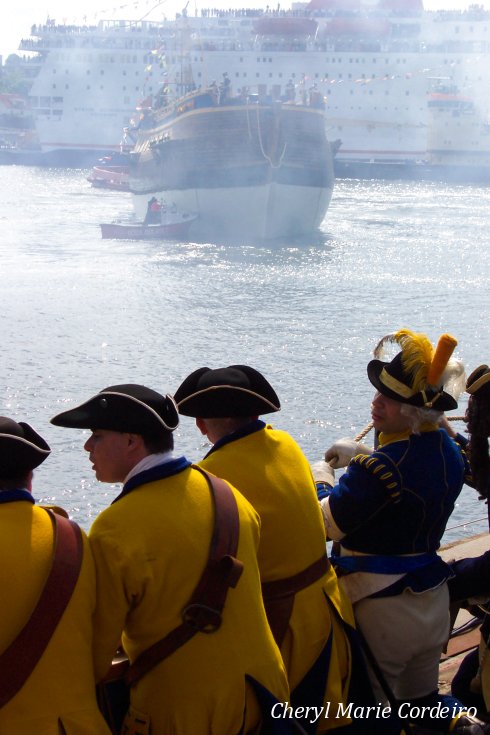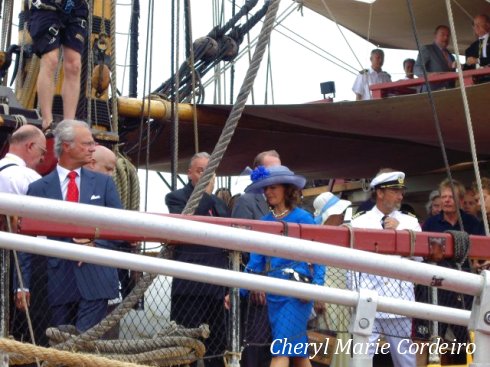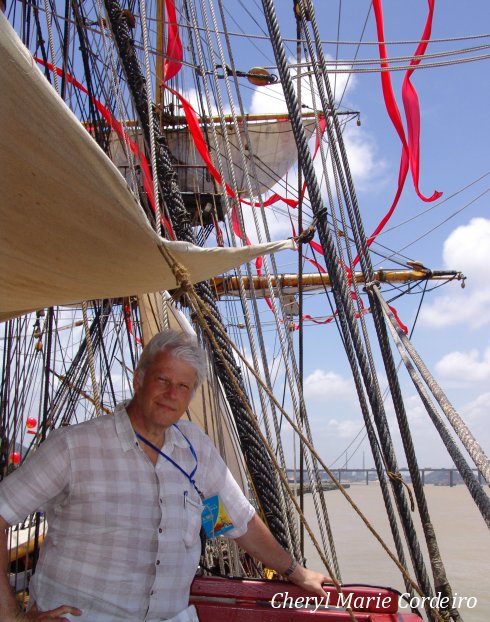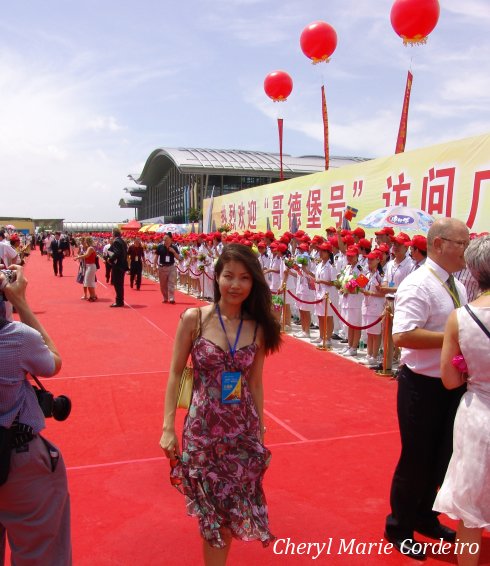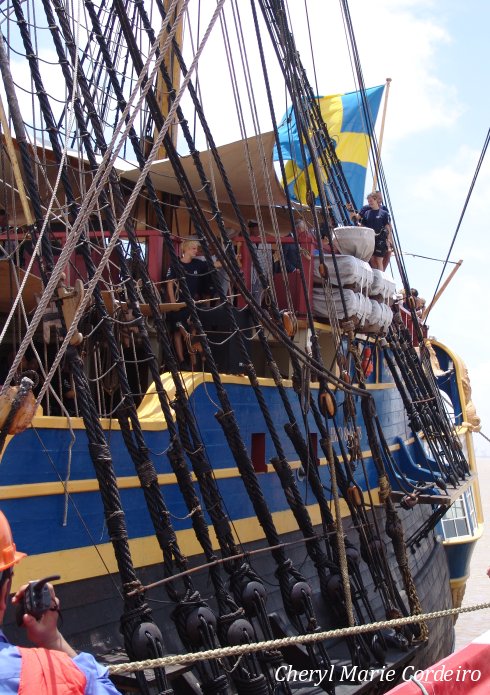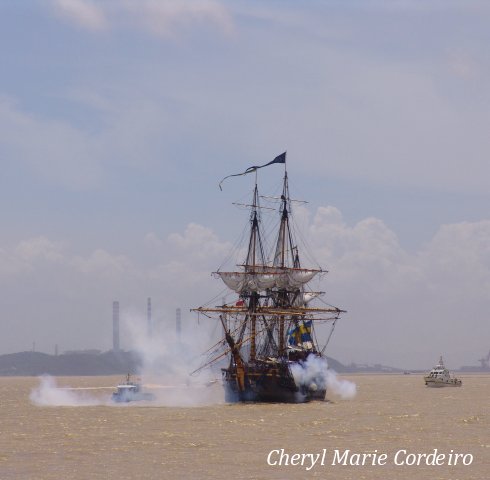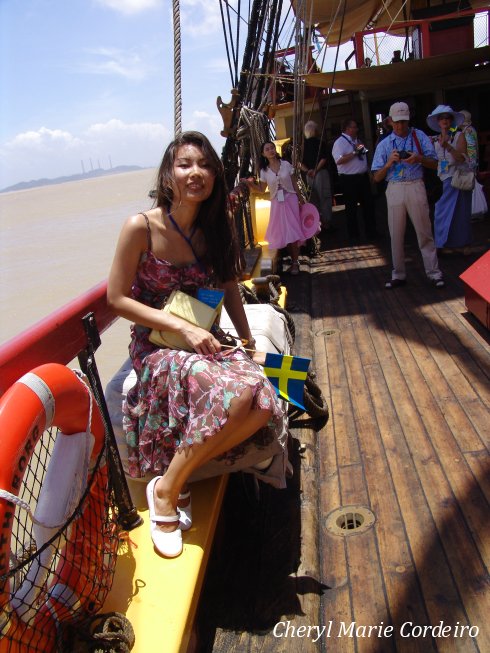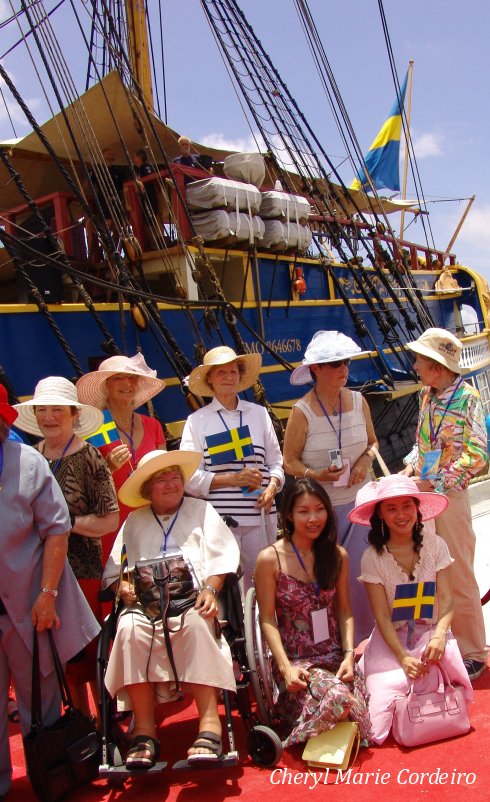In 2003, launching of the Swedish East Indiaman Gotheborg III
Photo © JE Nilsson and C M Cordeiro-Nilsson for CMC 2003-2011
My personal involvement in the Swedish East Indiaman Gotheborg III project was so early that I had not myself realized it back then. In the project newspaper GotheborgsPosten that was distributed in 360,000 copies throughout the entire western Sweden in 1996, it was outlined that one of the research objectives that would be targeted was Swedish-Chinese Business Communication. The Professor that in 2003 would arrange for me to receive the Anna Ahrenberg Research Funding Scholarship to help me start a PhD research (graduated in 2009) in doing precisely that, was interviewed. Strange indeed are the paths of life. Today, I go off to work everyday by ferry straight across Wargö Håla, the historic departure point of the Swedish East Indiamen in the western Swedish archipelago. In fact the house in which we live features one of the ship’s actual water provision wells in our very garden.
Currently at work, at the University of Gothenburg School of Executive Education AB, prevalent topics of discussion circle around Swedish-Chinese business relations and the future of work prospects with Sweden’s competitive growing economy that earned acknowledged nods from Swedish leaders, specifically that of its Finance Minister, Anders Borg, of the country being a Nordic tiger economy (ref. Di, DagensPS and Epoch Times). All this showing that the Swedish East Indiaman still has a relevant role to play, more so today than ever in its importance of growing global contacts. Its shared goodwill initially created by the East Indiaman Project is everywhere present.
In the media recently, a passionate discussion has arisen about what to do with the ship, now when its initiating ideas have been completed – the ship built and it has traveled to China and back. What now?
Many suggestions including turning it into a museum, an amusement park and why not – firewood – have come forth. Personally not even at today’s energy prices does the idea of firewood sound very brilliant.
Eventually, the original Founders of the project have chosen to step forth, and in this weekend’s local newspaper GP, have briefly presented their views of how the ship could continue to earn its keep and do much more than that.
The following article were published in GP, in January 22, 2011, as part of the ongoing debate about the future of the Swedish East Indiaman Gotheborg III ship.
H.M. King Carl XVI Gustaf and H.M. Queen Silvia, disembark the Gotheborg III in Canton, China, 2006.
From the point of view of Anders Wästfelt and the Think Tank Gotheborg, the ship is far from done sailing:
”In view of the past few days defensive debate in the media and our City Council, on the future of the East Indiaman Gotheborg, it is time to lift our eyes beyond the horizon. In the right hands the Götheborg III – our ship – is a regional and national asset with huge potential.
She has great future tasks, functioning as a symbol of our community, an inspiration for continued work and as a source of financial revenues. She is well-built and with proper maintenance, she can sail for another 20-30 years.
The project to build a replica of the 1700s Swedish East Indiaman began in 1992 as a private initiative. It was well thought through and enjoyed the support of international shipbuilding expertise, the best marketing specialists, lawyers, economists, politicians, sinologists, university faculties as well as members of the Swedish Ministry of Foreign Affairs and the Swedish Trade Council.”
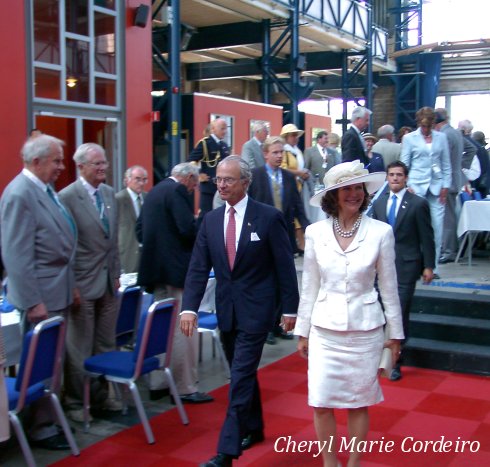
At the launch of the Gotheborg III with H.M. King Carl XVI Gustaf and H.M. Queen Silvia of Sweden, in Gothenburg 2003.
The Swedish East India Gotheborg III pulls a thread not just through the history of Sweden, connecting the Royal Family to its people beyond the heart of Stockholm, but it pulls together the trading history of Sweden, of Gothenburg together with Stockholm, with the greater part of Asia.
Everyone we met – from personal friends to the man on the street – all the way up to the Swedish Royal Family, understood what we wanted to do and offered their support. Already during the excavation period the Gothenburg industry thought that the idea was brilliant and offered their support.
To all of us, it was obvious that the strife and horrors of the past century in the East were soon to be over, and that China, often described as a sleeping Dragon just two decades ago, was about to awaken. In this aspect, Sweden in its unparalleled position as a peaceful trade partner since 1731 will have its unique opportunity to reconnect with China, as old friends would.
Jan-Erik Nilsson, onboard the Swedish East Indiaman Gotheborg III upon its arrival in Canton, China, 2006.
Let us look up
When the newly built East Indiaman Gotheborg III set sail in October 2005 east bound, it was the result of the support of tens of thousands of people and organizations who were dedicated in their efforts, work and devotion to a vision, reflecting a symbiotic Swedish-Chinese foresight in planning that contributed to the ship’s success!
The Swedish East Indiaman Gotheborg III is more than mere public relations. It is an inspiration that spurs action from people across the globe! Here, the crowd in Canton, China in 2006, when the Swedish East Indiaman Gotheborg III arrived.
The reception the Gotheborg III received in China was amazing! Everyone from school children to international journalists at the press booths awaited with eager anticipation for it to enter the muddy waters of the Bocca Tigris, the harbour in which the ship would historically dock in exchange of goods, culture, news and new-world insights. The experience of it all was priceless!
On the red carpet in a Diane von Furstenberg dress, awaiting the arrival of the Swedish East Indiaman Gotheborg III into China, 2006. Everyone from school children to the Press were prepared to meet the ship that was the concrete symbol of a bond between Sweden and China.
The value of goodwill, the increase in knowledge from the exchange of it through trade, learning and a continuous education, the encouragement of a change in attitude towards developing global networks and contacts through this very project has already been created. There isn’t any better time than now for Sweden, in the age of a rising China, to continue to build upon its well-founded and friendly affinity with an Old Friend that has taken centuries and great efforts to cultivate in relationship. There are only rewards to be reaped from both sides, none of which benefit from a defunct symbol turned into a shopping mall or architectural landfill that mars more than decorate inland.
The colours of Sweden on the Swedish East Indiaman Gotheborg III belong in international waters!
So, let us raise our sights to what lays beyond the horizon today. Let us call all good forces back, to once again contribute to, that our ship the Gotheborg III, shall remain the shining symbol it is for Sweden, and plan for everything it can be used for in the near future.
In fact, far from becoming redundant in modern times, Gotheborg III will act as a focal point for Swedish international business and entrepreneurship, taking care of our young people by giving them a secure branding of their country. The ship’s various and multi-faceted domains of interest will also mean that it can work multifariously without diffusion of purpose, towards an understanding of history, of modern corporate social responsibility, sustainability, all larger environmental activities, at the same time promoting cultural exchange and understanding. Sailing in international waters, the Gotheborg III continues to represent the value of authentic, longterm friendship, shared knowledge in research and brings home the true meaning of peaceful trade.
The Swedish East Indiaman Gotheborg III, empties Her cannons as a sign of peaceful trade before entering each harbour.
The ship’s voyages can be combined with exhibitions and continued education. Both in modern navigation systems in commercial applications, the study of languages, international trade, leadership and business administration.
Its symbolic value is created as to be involved in projects pertaining to infrastructure, architecture and design, with the creation of international trading houses that contribute to the business development between Sweden and Asia.
On deck in Canton, China, 2006.
Our ship, the Gotheborg III, has already pulled in billions of dollars in marketing value to the Swedish society and has given tens of thousands of people who have worked and sailed with it, genuinely priceless experiences that inspire greater fellowship, social rapport and personal achievements.
There is no reason for this to stop now!
The Swedish East Indiaman Gotheborg III has encouraged friendship across nations, a cross-cultural exchange of ideas and continues to be a concrete symbol of Sweden’s core values of entrepreneurship and peaceful trade between nations.
An indispensable symbol
The ship is an indispensable symbol of Sweden as a nation, for the Swedish culture and industry and above all as an inspiration for what courage, determination and entrepreneurship can bring.
The basis for the ship’s future is however a sound financial basis and long-term planning. It is our firm conviction that the owning Foundation with enthusiasm and a clear vision about the purpose of the ship can create this basis together with all those who have, and will benefit from this ship now, and in the future.
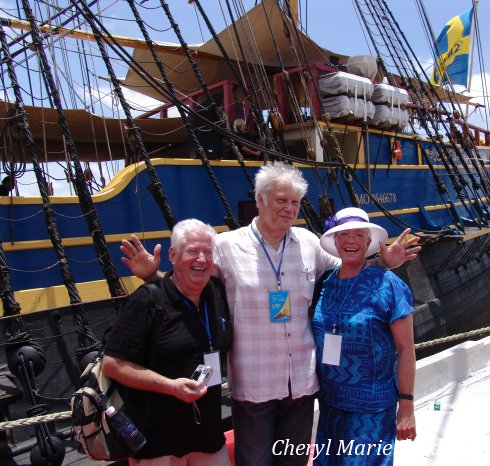
Modern Supercargoes: Jan-Erik Nilsson, Anders Wästfelt and Berit Wästfelt who are part of Tankesmedjan Götheborg.
Think Tank Gotheborg
Think Tank Gotheborg was formed in September 2010 on the occasion of the current foundation assignment ends in 2011. The members are Bo Alfredsson, Peter Kaaling, Jan-Erik Nilsson, Ludvig Nilsson, Bertil Philipson, Bengt Tengroth, och Anders Wästfelt.
